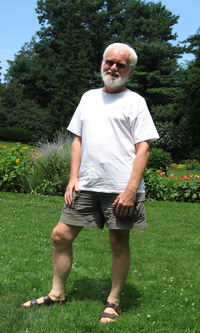 |
Poetry and cockroaches
Interview with Philip Holmes,
Princeton University,
by Hinke Osinga,
University of Bristol,
UK |
| Philip Holmes. |
|
Phil Holmes has got an impressive CV. Not only has
he initiated many new areas of research in mathematics, he is also
very much interested in literature and has published four volumes of
poems. Perhaps because of this, his career path has taken him all over
the world and for a long time it was not at all clear where it would
lead him. Phil was born in the UK and studied Engineering Sciences at
Oxford, while
attending many lectures in literature at the same time. His studies
formed the "middle part" of a thick-sandwich apprenticeship at
Rolls Royce and
he was clearly destined for a promising career in industry.
Unfortunately, Phil hated working in a company, and especially the
clocking in. He resolved to stop being an engineer and make another
start as a poet.
|
|
 |
| Phil Holmes with
his father in 1945. |
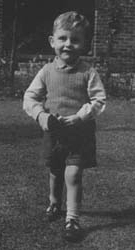 |
|
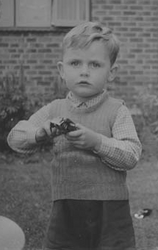 |
| Phil Holmes at the
age of three. |
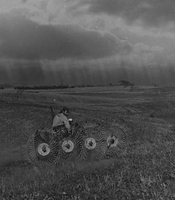 |
|
In 1969, after a
year of writing, he went on a hitchhiking trip through Europe, Greece
and Turkey until the autumn. He stayed in Israel on a kibbutz for
winter and planned to continue his trip through Turkey, Iran and
Afghanistan to India. "But things took a completely different turn
when I met Ruth at the kibbutz. We went back to England in 1970, got
married in November, and now I needed a job!" On the basis of his
first book of poems Three Sections (which was to be published
in 1972), Phil tried to find a job as an English teacher, but then "a
trusting far-sighted guy named Bob White at the
Institute of Sound
and Vibration (ISVR) in Southampton offered me a job as a
lab assistant to help build experiments." The job proved far more
interesting than Phil had expected. Moreover, Robert White felt that
his activities were rather valuable: "You could get a PhD for this,
you know. Why don't you go and pay the fee?" Phil received a PhD for his
work on "The Experimental Characterisation of Vibration Transmission
Using Transient Excitation" in 1974.
|
| Raking hay with
oncoming storm in northern Negev, Israel,
1970. |
Despite having resolved not to become one, Phil was
now an established engineer. He took a postdoctoral position under
Bryan Clarkson, who was also the Director of ISVR. As a result, Phil
could work on whatever he wanted. "I met
David Chillingworth and
David Rand, who were both in the
School of
Mathematics at Southampton. I took David Chillingworth's
catastrophe course and David Rand and I studied the famous Utrecht preprint of
Floris
Takens. This is how I became fascinated with dynamical systems
theory." However, Phil was also still passionate about his writing and
in 1977 he published another book of poems A Place to Stand,
which was written in Southampton and partially based on his travels on
foot in the middle-east. "Unfortunately, due to my work in dynamical
systems I had made myself unemployable in England. If I applied for an
engineering job, they were surprised because I did mathematics, but if
I applied for a job in mathematics, I was told that I didn't have a
mathematics degree." Profiting from contacts made at a conference
organised by David Rand in 1976, where Phil met John
Guckenheimer, Jerry Marsden, and
Nancy Kopell, he received an offer in 1977 to join
the Department of Theoretical and Applied Mechanics
(TAM) and the Center for Applied Mathematics at Cornell
University. Phil began collaborating with Jerry Marsden before he left
the UK, and he and John Guckenheimer started work on their textbook
Nonlinear
Oscillations, Dynamical Systems and Bifurcations of Vector Fields
during Phil's six-month visit to Berkeley in 1981. John subsequently
moved to Cornell in 1985. "It was a very good environment for
interdisciplinary work. TAM and Applied Mathematics did most the
mathematics education at the university and this automatically got one
involved in a broad range of projects." Phil stayed at Cornell until
1994, when he left for Princeton University to become Professor in Mechanics
and Applied Mathematics, with joint appointments in the
Department of
Mechanical and Aerospace Engineering and The Program in
Applied and Computational Mathematics.
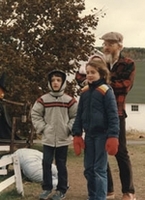 |
|
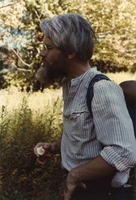 |
| Phil
Holmes with his children near Ithaca in early to mid
1980s. |
Common themes between mathematics and poetry
According to Phil, an applied mathematician needs
to keep his or her eyes open. It is not sufficient to focus on
mathematical theory; one has to know something about other things than
mathematics. "Many people who made advances in science have had wide
interests. Making connections requires breadth." While Phil does not
believe that there are direct connections between mathematics and
poetry, there are common themes. "Applied mathematics and poetry are
both ways of coming to terms with something outside." In applied
mathematics, the ouside is whatever you want to apply the mathematics
to. In poetry, it is what the poet writes about. "My third book,
The Green Road, was written at Cornell from 1977-1986. Part
of it deals with the history of lead mining in Northern
England, because I had lived in this lead mining area years
ago. Writing a poem about lead mining means that I must adhere to
poetic and literary structure. I must think about how to use language
and the literary baggage that words or phrases may carry, while at the
same time I consider the historical facts of a miner's life. In
applied mathematics we have a similar relationship to mathematical
history, in that we place our work in the context of previous
literature, and we use a particular framework and techniques to come
to our results." Ultimately, your interpretation depends on what you
know and how you write. Of course, you want to do something original,
but you still see things through a lense of what has been done and how
it was presented before. "Can you ever look at something without a
model of what you want to see? I try to look for a literary metaphor
when choosing my mathematical approach. The fact that these things are
going through my mind --- sometimes at the same time --- is not
irrelevant. It helps me to realize that there are many different ways
to understand something. Being interested in poetry has helped me to
be a bit more humble about what mathematics can achieve."
Phil's latest poem started off with memories from
his hitchhiking in Turkey. He is reworking it because his perception
of the world has changed over the years. "This poem is about how your
mind grows and parts of it die and how it changes." A poem gets
rewritten over and over again to capture the exact image or a
combination of images. "For example, you have a memory of light
falling on trees, along with a memory of some nice experience, but you
also worry about the kids at home. Just imagine trying to formulate
this feeling using such a compact language as mathematics!" Of course,
this may be a bit too far-fetched, but Phil has a seven-year
collaboration going with
Jonathan Cohen, Professor in Psychology and
co-director of Princeton's
Neuroscience Institute. "We are interested in the
problem of how we can share attention among different tasks while
there are a lot of demands on our brain. How can you explain how we
think about things, the richness of our senses? We can use stochastic
ODEs to model the accumulation of evidence in simple decision tasks,
but can one mathematize the full range of experiences?" Phil is
very glad to be involved in this complicated project of how humans
think. "I include ideas from neuroscience and try to put in images of
how things flow. It is difficult to draw it all together, but this is
also a metaphor for research: it pulls you in lots of directions."
|
In many ways the
practical criteria that we use in both poetry and mathematics are the
same. The judgement of whether a phrase stays in a poem is similar in
nature to the decision of which proof is more elegant. However, do
such similarities still apply in dynamical systems? "I would proof a
theorem whenever I can, but there is often a tension between what you
can proof and the limitations you have to put on the object of study
to achieve a proof, the hypotheses, etc." Hence, Phil has not been
active recently in basic theory. "Too often one must impose
limitations on exactly those effects that one wishes to include. It
becomes a compromise, since we do resort to numerics, but still need
the theory to help interpret them. Furthermore, my applied
collaborators are typically not interested in proofs. They want to add
even more bells and whistles, and so take away even more from the
possible tractability."
|
|
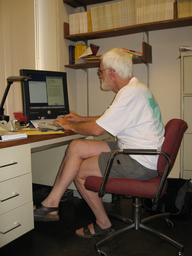 |
| Phil Holmes in his
office. |
Collaborations as eye-openers
Phil has got many collaborators and he is
convinced that collaborations are very important. "Especially the
postgraduate students and postdocs in biology have a very broad
interest --- they tend to be older than their equivalents in
mathematics --- and it is nice to be involved in neurobiological
applications." Phil has several long-standing research
collaborators: "I have been blessed with a wonderful succession of
postgraduates, postdocs and colleagues." As mentioned, there is his
work with Jonathan Cohen, and he is studying insect locomotion
with Bob Full (UC Berkeley),
Dan Koditschek (University of Pennsylvania), and
John
Guckenheimer (Cornell). "My first interest in neurobiology was in
central pattern generators. At Cornell, around 1980,
Avis Cohen (now at the University of Maryland),
Richard
Rand and I started to investigate the swimming motions of
lamprey. Avis and I met by chance waiting in line for the Math
Department copier. More recently, we teamed up with Thelma
Williams (St.George's Hospital Medical School, University of London)
on muscle models, and
Alexander Smits (Princeton) got involved because of
his experimental work on unsteady oscillatory propulsion --- the
hydrodynamics of swimming."
The common theme for all of these collaborations is
to try to build integrated models from known components. "We know quite a
lot about the components, in the end the mechanical motion all comes
down to Newton's laws, while we have a central pattern generator for
the neurobiological component. It seems important and feasible to
build relatively simple models that show how all bits are
integrated. It's like a marriage of neurobiology and mechanics in
which the overall view is important, and breadth is critical." Phil
likes going on to new things, but his three main projects share the
common theme of asking how neuronal spikes get turned into behavior,
how neurons make their imprints on the world. "I feel very lucky to
have fallen into such an interesting area of research --- and it was
by chance --- and then to have had appointments that let me explore
freely, and to have had great collaborators and colleagues."
In practice, Phil tries to straddle the boundaries
among proof, asymptotics, and numerics. For example, his work on
insect locomotion seems to require a model describing the movements of
six legs. However, insects typically use their legs in groups, so one
can simplify to a two-legged model. "In the end, we reduced to an even
more simplified model where we essentially deal with only one pogo
stick. This meant we could actually proof stability results and it
turned out that this was quite useful for interpreting numerical data
from more realistic models. I believe we do want models that are as
simple as possible, because going to the limits can be very helpful."
Nevertheless, the current model now has six legs and muscles are being
included. So, there are more components, more parameters and more
inputs. It might be able to proof something for this complicated
model, but Phil wonders what its value might be. "It is perhaps more
elegant to come up with a nice algorithm and use numerics than an
elaborate proof that does not illuminate or explain anything.
 |
|
Phil's activities
span a very broad range. Not only has he used his skills in fields
from solid and fluid mechanics to nonlinear optics, pattern
formation, biomechanics, neuroscience and cognitive psychology, he
also continues to learn about other skills from different scientific
fields. "I do see a shift in what I am doing. For many years, I would
have said that I was in dynamical systems, but now I am much more
focused on particular applications areas. I work on building models
that are simple enough to do analysis on, and I use only basic tools
from mathematics. Sometimes, I feel I am not up to date with what is
going on in dynamical systems..."
|
| Phil in July
2006. |
That is quite a strong statement from the chair of
the SIAM Activity Group on Dynamical Systems! However, Phil points out
that it is also a comment on the level of activity in the field. "Who
can keep up with the flood of literature and preprints in such a
vibrant field?" And he adamantly opposes the suggestion that he may
not be up for the task. "I may have moved away from basic theory
myself, but it is still very important. Applied mathematics is a very
broad field and dynamical systems needs to maintain its coherence at
the center of a range of fascinating technical problems. For example,
we must export our knowledge of finite-dimensional systems to PDEs and
DDEs, we should better unify the relatively new field of stochastic
ODEs, and come up with general results in ergodic theory that are
applicable in a wide context. It is really important to have abstract
theorists ask themselves whether they can find a
C3 counterexample to this or that. But for myself,
I'm currently enjoying the ground work of modeling, which means lots
of reading and collaboration." Phil points out that the member of
SIAG/DS, and even more the participants at the biennial Snowbird
meetings, come from many different areas --- not only from
mathematics, but also from physics, engineering, and now biology,
finance, etc. "Our community has spreading roots and a broad canopy,
and that is terrific." He goes on to explain that we must take care of
the coherent center and the tap root in dynamical systems theory,
because otherwise the tree would fall. "Take complex systems theory,
if it is a theory. How would you select a syllabus for a course, or
choose a coherent textbook? It is important to realize that in
dynamical systems we really do have a good view of the core discipline
and we should not lose sight of that."